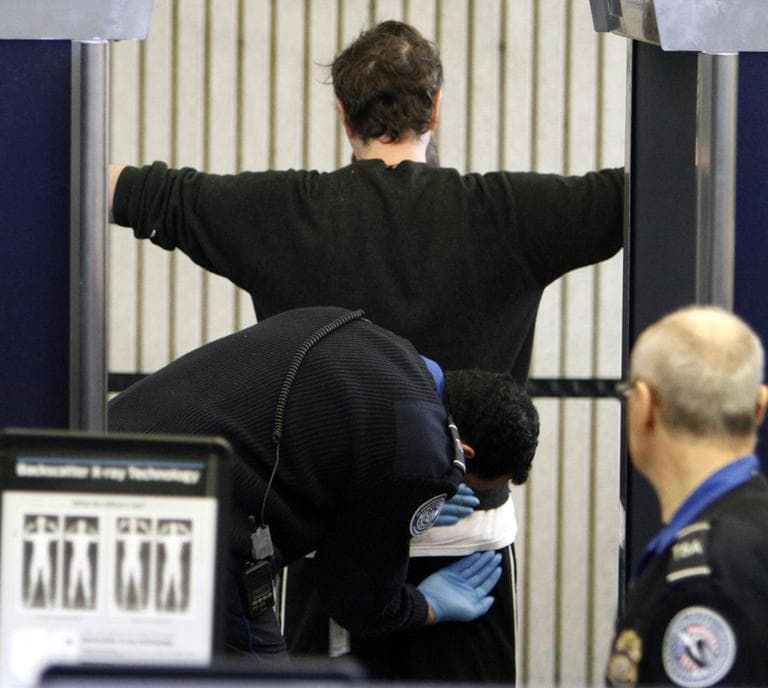Advertisement
Looking In The Right Place: Security At Logan, Then And Now
Resume
The two planes that crashed into New York City's World Trade Center on 9/11 departed from Logan International Airport. Since then, Logan has become the front line of experimentation with new security measures.
Peter DiDomenica says the world did not change on 9/11. The world, he says, was already as it was.
"But our perception of the world changed," he said. "9/11 was a wake-up call that we're not immune from what goes on in the rest of the world."
Looking at people's behavior is what Logan's latest security measure is all about. Seventy-four TSA officers at Logan have been trained to ask the questions and detect anomalies in behavior.
Ten years later, DiDomenica is a lieutenant detective on the Boston University police force. Recently, he was in front of the checkpoint at Terminal A, revisiting the airport where he helped put in place security measures still used today. On 9/11, he was a sergeant with the State Police. But it was only two months after 9/11 that he realized what was really wrong with security at Logan.
"I was actually working at the airport when the calls came in of a passenger that appeared to be trying to light his footwear on fire," DiDomenica said.
An American Airlines flight from Paris to Miami had been diverted to Logan. DiDomenica was providing security on the airfield.
"It was the real deal," he said. "He was a committed terrorist that was willing to give up his own life, came close to doing it, and almost took 200 people with him over the Atlantic Ocean."
Two months after 9/11, a realization sank in.
"This threat is real," DiDomenica admitted to himself, "and it's not going away."
Security Technology In Airports
DiDomenica took away some major lessons from the day he saw shoe bomber Richard Reid being taken off that plane at Logan. One of them was that they needed better technology to detect bombs.
"The whole reason why Reid was able to board that plane in Paris the way he did was a paper detonator," said Middlesex District Attorney Gerry Leone, who prosecuted Reid, "because there were no metallic components to his shoe, which would have been picked up on the technology at the time. Reid learned that in the al-Qaida camps."
Ten years later, the security checkpoints at Logan Airport now have technology that would find that shoe bomb.
DiDomenica says we've only gotten to this point by trying out some clunkers.
"I know when I was at the airport, we looked at facial recognition technology," he said.
But it turned out that the face recognition technology could not pick out a face in a line.
Another failure: the machines security people call "the puffers."
"That was a kind of little cage you stepped into," said George Naccara, the federal security director at Logan. "It blew air around you. It was supposed to just disturb the particles on you, and then it would sense the particles and indicate if you had explosives. We found that it had too many false positives, and it just slowed the process down too much."
Ten years later, DiDomenica says Logan's experiments with technology have paid off.
"The devices are so good now that they raise civil liberties concerns," DiDomenica said. "You have this advanced imaging technology that basically undresses you, and it's so good that there's a pushback that it's too good."
Detecting Suspicious Passengers
DiDomenica recognizes the importance of technology, but he says it's not the most important part of security. The right equipment would have helped French police keep Reid off the plane, but DiDomenica says it would have been more helpful if they could have kept him off even though they couldn't find a bomb. After all, they knew something was wrong with him.
"Reid actually fit what you may call a profile of a 'suspicious passenger,' " he said, "and he was questioned extensively before his flight, so much that he missed the plane."
Police couldn't find anything on him.
"So he was put into a hotel for the night so he could make the same flight on the next day," DiDomenica said. "He was again questioned. They couldn't find any type of device, and so he was allowed to proceed onto the plane. The big lesson from that is that there may be situations where there are really dangerous people, they're actually on their way to conduct a violent attack, and we need to be able to slow them down or stop them even if we can't find the device."
DiDomenica says Logan learned that second big lesson: focus on who is getting on the plane, not what.
"We shouldn't lock people into this thinking about just finding a prohibited item," he said. "That was the mistake of Richard Reid, focusing on the item, and they get it now. They're looking at people's behavior."
Looking at people's behavior is what Logan's latest security measure is all about. The airport's security director, Naccara, says during part of each day, each passenger at Terminal A is questioned.
"The questions are innocuous," Naccara said. "We may ask where you're traveling, how long you've been in Boston, did you pack your own bags today? But we're gauging their reactions. We're looking for inconsistencies in their story, something out of the ordinary that would cause us to say this person should be looked at a little bit closer."
Seventy-four TSA officers at Logan have been trained to ask the questions and detect anomalies in behavior.
Unlike DiDomenica, who's focused on the airport, American Airlines pilot Rich Girard says what goes on at the airport isn't even the most important part of security. Getting ready to fly to London, Girard said what's worked best are the security measures on the plane itself.
"The armed pilots are a great benefit," he said. "There's more federal air marshals now than there used to be, and the reinforced cockpit doors is a great spending of money."
Girard added that there's one more key component of security: the passengers.
"Nowadays, they're much more willing to stand up and do something if things go south, and able-bodied passengers have stepped up and done their part," Girard said. "And that's a big increase in security, too. We all count on that up front."
In the end, 10 years later, the two times terrorists have been stopped from destroying an aircraft, it wasn't because of all the security measures at Logan or any other airport. It's because passengers and crew grabbed them mid-flight before they could do any harm.
This program aired on September 9, 2011.
